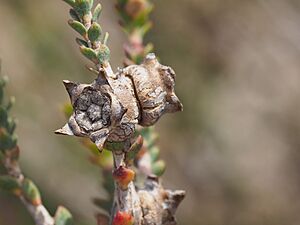Claw honey-myrtle facts for kids
Quick facts for kids Claw honey-myrtle |
|
|---|---|
 |
|
| Melaleuca pulchella (foliage and flowers) in Royal Botanic Gardens, Cranbourne, Victoria | |
| Scientific classification | |
| Genus: |
Melaleuca
|
| Species: |
pulchella
|
The Melaleuca pulchella, also known as the claw flower or claw honey-myrtle, is a special plant. It belongs to the myrtle family called Myrtaceae. This plant is found only in the southern parts of Western Australia. It's one of only two types of Melaleuca plants that have two different kinds of stamens. Stamens are the parts of a flower that produce pollen. The outer stamens on this plant are longer and curve, making the flower look like a claw! This is why it's called the "claw flower." It's a tough shrub that blooms for a long time, making it a popular garden plant.
Contents
What Does the Claw Honey-Myrtle Look Like?
The Melaleuca pulchella is a shrub that spreads out. It can grow to be about 1–2 m (3–7 ft) tall. It has many branches that arch outwards. These branches are covered with small leaves. The leaves are shaped like an oval or ellipse. They are about 2–6 mm (0.08–0.2 in) long and 1–3 mm (0.04–0.1 in) wide. If you cut a leaf in half, it would look like a crescent moon. The underside of the leaves has large oil glands.

The flowers of the claw honey-myrtle are usually pink to mauve. They appear from September to February, and sometimes even in April or May. The flowers grow alone or in small groups of up to four. These groups form small heads, about 20 mm (0.8 in) across. You'll mostly find them at the ends of the branches. The petals are 3.8–6.6 mm (0.1–0.3 in) long. They fall off as the flower gets older.
Around the flower, there are five groups of stamens. Each group has between 45 and 100 stamens! About 45 to 80 of these stamens are short and don't produce pollen (they are sterile). But 10 to 15 of them are long and curved. These are the ones that give the flower its "claw" look. After the flowers bloom, the plant produces fruit. These fruits are woody, urn-shaped capsules. They are about 3.3–4.5 mm (0.1–0.2 in) long and 6 mm (0.2 in) wide.
How Was This Plant Named?
The Melaleuca pulchella was first officially described in 1812. This was done by a botanist named Robert Brown. His description was published by William Aiton in a book called Hortus Kewensis. The second part of its scientific name, pulchella, comes from the Latin word pulchellus. This word means "very pretty." It was chosen because of how lovely the flowers of this plant are.
Where Does the Claw Honey-Myrtle Grow?
The Melaleuca pulchella grows along the south coast of Western Australia. You can find it from Hopetoun all the way to Israelite Bay. It grows in sandy soils. You might see it on flat plains, sand dunes, and even in swamps.
Is This Plant Protected?
The Government of Western Australia's Department of Parks and Wildlife says that Melaleuca pulchella is "not threatened." This means it is not currently in danger of disappearing.
Growing Claw Honey-Myrtle in Your Garden
The Melaleuca pulchella is a popular plant for gardens. People love its small size, how long it flowers, and its beautiful "claw" flowers. It grows best in soil that drains well and likes a bit of extra water. However, it can adapt to most garden conditions. Unlike many native Australian plants, it can handle some phosphates in the soil.
Images for kids




